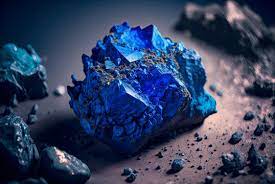Identity.
Cobalt is a naturally occurring element in the earth's crust. It occurs in several minerals, often with nickel, silver, lead, copper, and iron ores (Haynes 2015). It is a member of Group 9 of the periodic table along with rhenium, iridium, and meitnerium, and adjacent to iron and nickel.
Atomic Structure:
The nucleus consists of 27 protons (red) and 32 neutrons (blue). 27 electrons (green) bind to the nucleus, successively occupying available electron shells (rings).
History.
For centuries, humans have been captivated by the vibrant blue hues produced by cobalt compounds. Ancient Egyptians, Persians, and Chinese artisans all used cobalt to color their pottery, glass, and jewelry, leaving behind stunning testaments to its beauty.
The element itself, however, remained a mystery until the 18th century. In 1739, a Swedish scientist named Georg Brandt finally isolated cobalt, separating it from the arsenic-rich ores that had frustrated miners for generations. He named the new element after the German word "kobold," a mischievous spirit miners blamed for their failed attempts to extract other metals.

